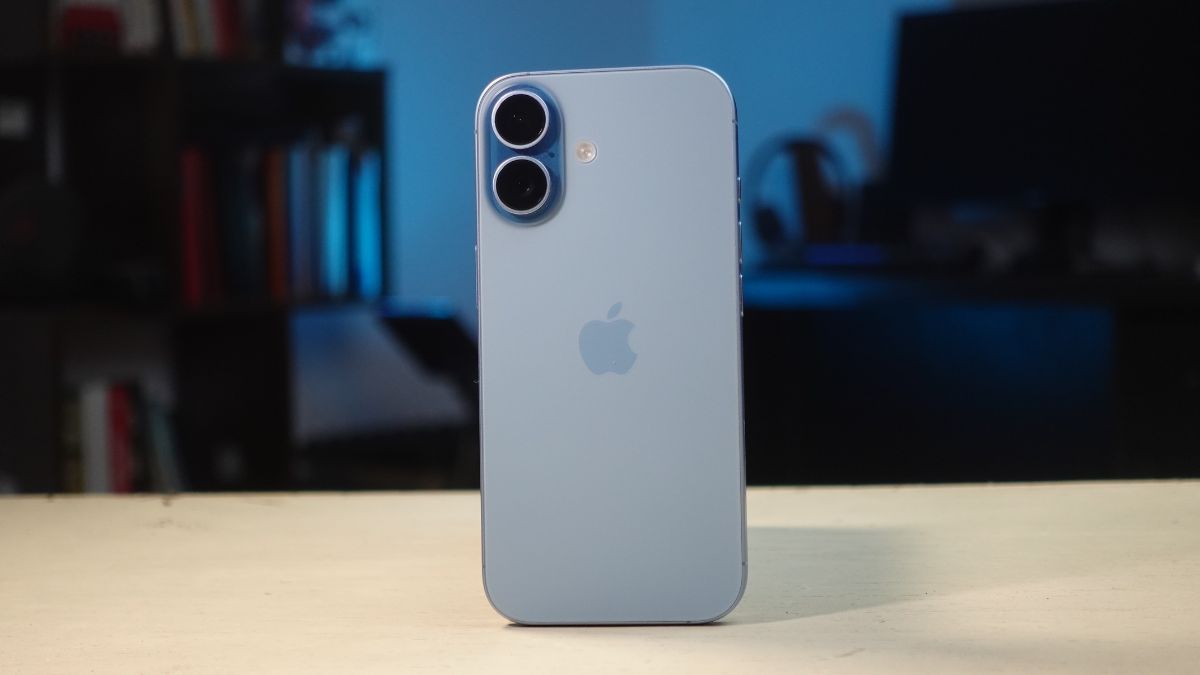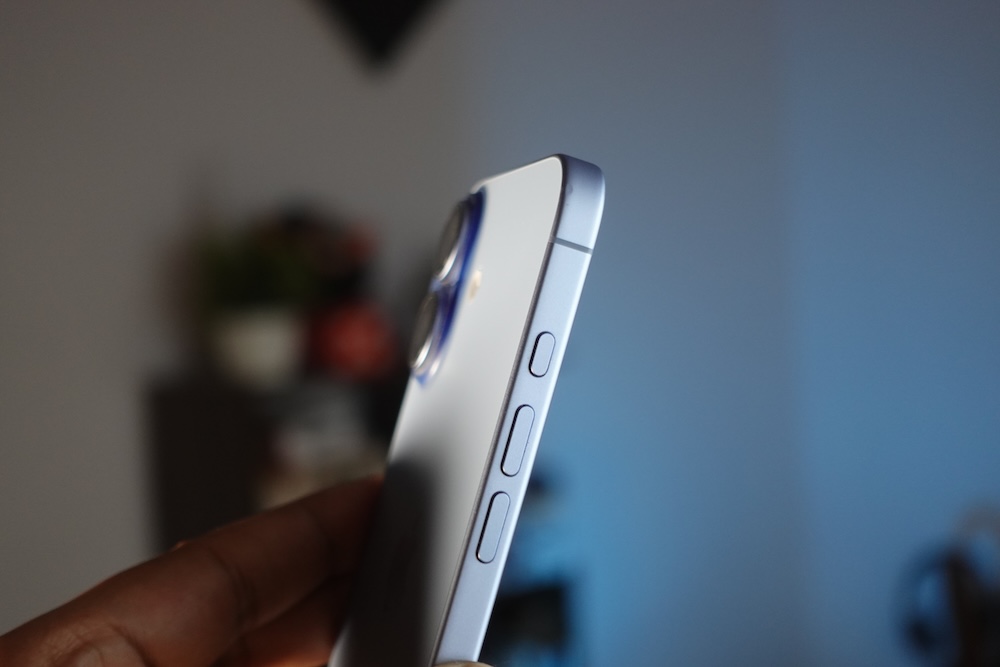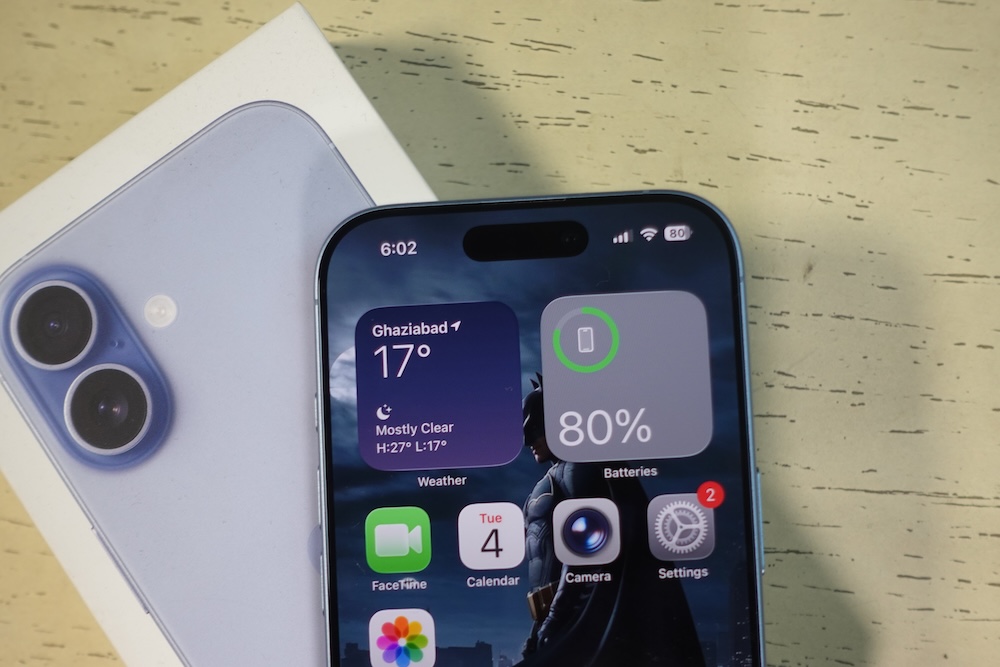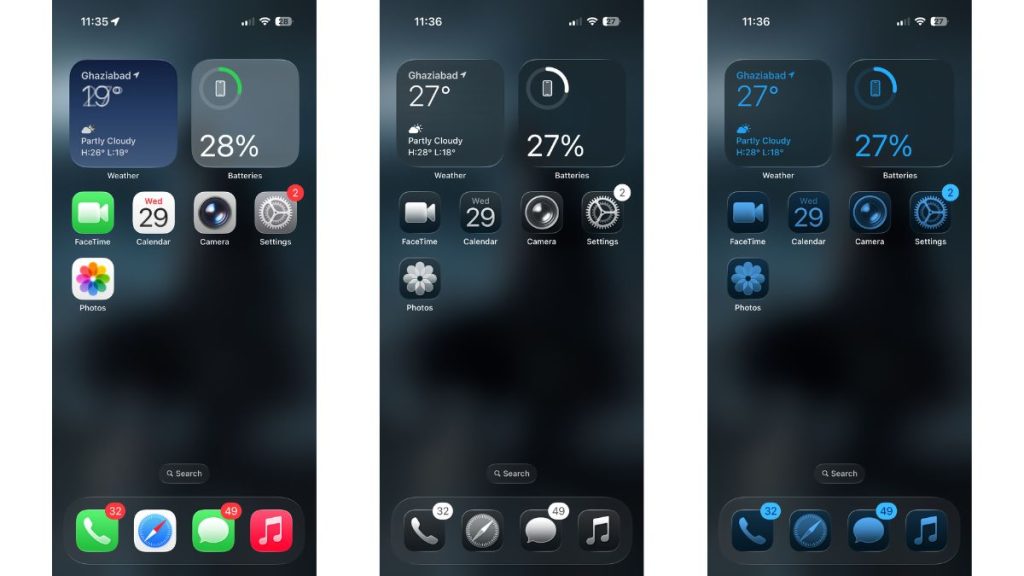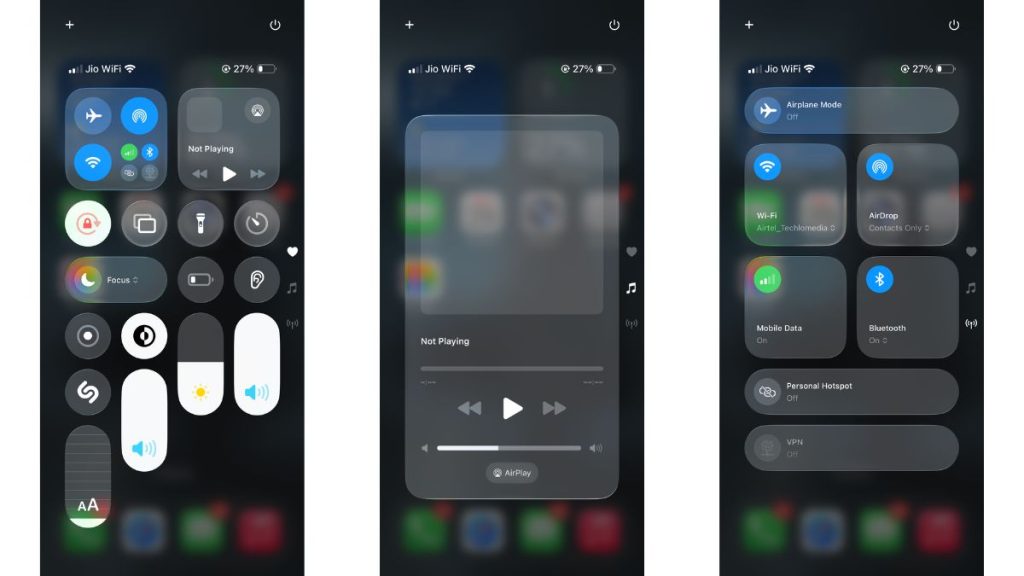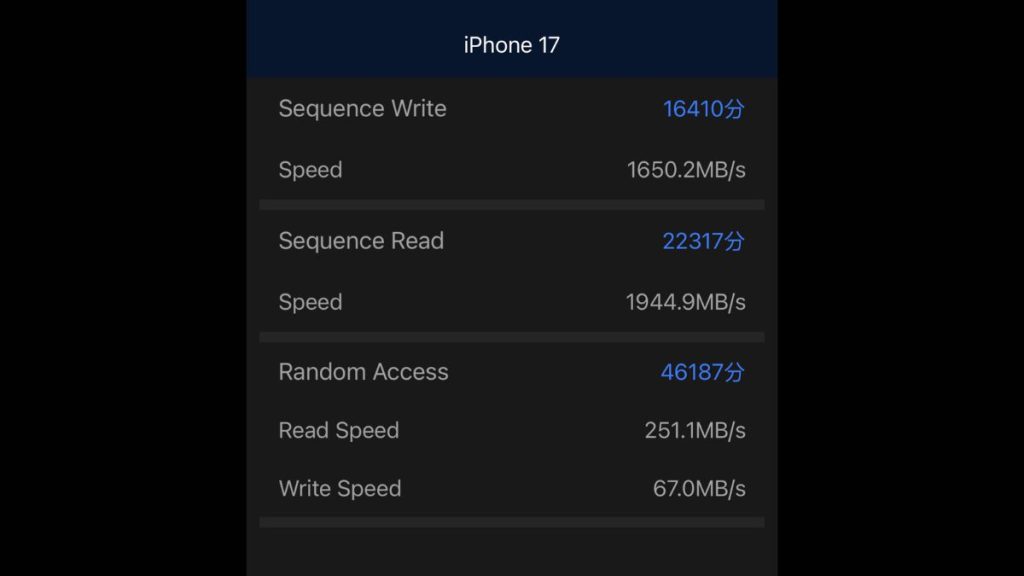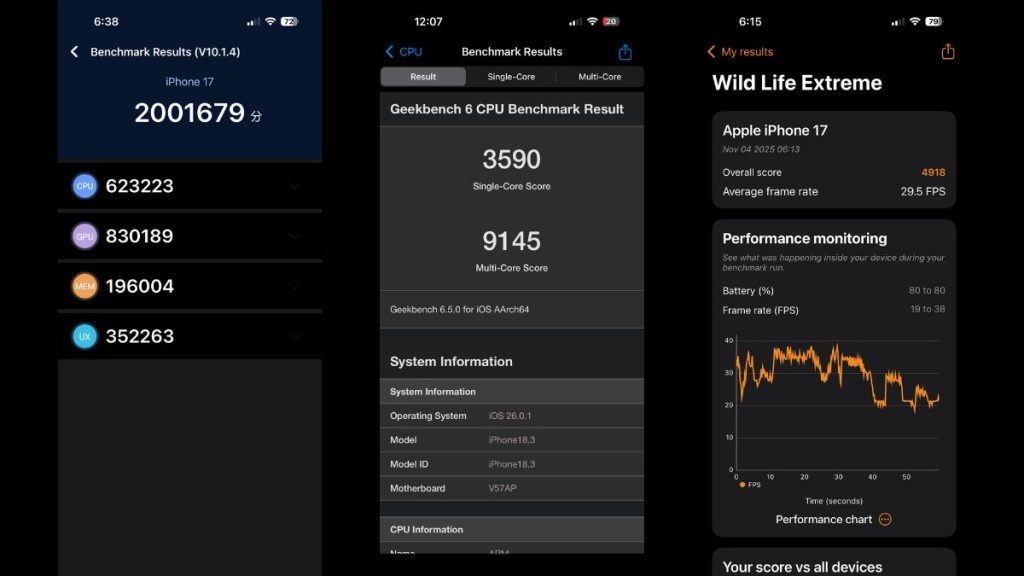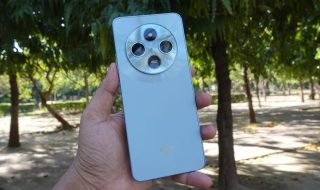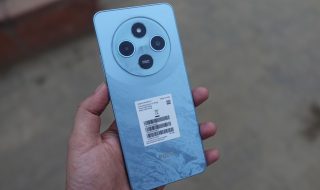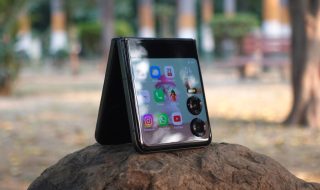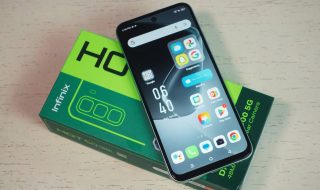The iPhone 17 is finally here, and Apple claims it is its most advanced iPhone ever. From a sleeker design and improved cameras to a more powerful A19 chip, this phone promises a big leap forward. But with prices higher than ever and strong competition from Android flagships, is the iPhone 17 really worth the upgrade? Let’s find out in this detailed review.
iPhone 17 Review
Design
The iPhone 17 is the only model in the iPhone 17 lineup that sticks to the same design as last year’s iPhone 16. That means you do not get the new rear glass insert like the Pro models. For some people, that might be disappointing because the new Pro design clearly stands out and shows that you have the latest iPhone. But others will appreciate the simplicity and the clean look of this standard model.
The phone still features a single solid glass back with a beautiful, vibrant color. Apple has, as usual, refreshed its color palette this year. You can get the iPhone 17 in classic Black or White, and also in new Mist Blue, Lavender, and Sage shades. The Mist Blue version that I have looks subtle and soft with a pastel-like tone, instead of being overly bright or flashy. It feels elegant and modern without trying too hard.
The camera island is a slightly deeper version of the main color and has a smooth gradient finish. It adds a bit of character without being too shiny or loud. The aluminum frame around the phone is color-matched perfectly with the back panel. The sides remain flat, but the edges are rounded just enough to make it comfortable to hold. In-hand feel is excellent.
The iPhone 17 still uses a classic “glass sandwich” design, unlike the unibody titanium build on the Pro models. The frame is made of aluminum, which gives the phone strength and rigidity. It feels durable, and there is almost no flex. The front and back are both covered with large glass panels. The front uses Apple’s new Ceramic Shield 2, which offers excellent scratch and shatter resistance. The back glass also uses a newer Ceramic Shield variant that Apple claims is four times more crack-resistant than before.
However, the aluminum frame does attract smudges and fingerprints quite easily. You will need to wipe it often to keep it looking clean. The back glass, on the other hand, has a soft, silky texture and does not get dirty as easily.
The right side houses the Side button and just below it, the dedicated Camera Control key. On the left side, you get the new programmable Action button followed by the volume keys and, below them, the Nano-SIM tray. At the bottom, there is a USB Type-C port, a main microphone, and one of the stereo speakers. The earpiece above the display doubles as the second speaker.
Speaking of proportions, even without putting it side by side with last year’s iPhone 16, you can tell that the bezels have become thinner. That is because Apple has finally given the vanilla iPhone the “Pro” display this year. The screen has grown slightly from 6.1 inches to 6.3 inches, with slimmer bezels. However, this also means the phone itself is a bit larger overall.
It measures 149.6 x 71.5 x 8 mm and weighs 177 grams. That makes it about 7 grams heavier than the iPhone 16. The difference is small and totally acceptable considering the upgrades. Interestingly, it is still almost 30 grams lighter than the Pro model with the same display size.
The display continues to feature the familiar Dynamic Island at the top. It houses the new 18MP front camera, the structured light 3D sensor array for Face ID, and the proximity and light sensors. The overall layout feels familiar but refined.
The phone also maintains an IP68 rating for water and dust resistance. It can handle being submerged in up to six meters of fresh water for 30 minutes.
Overall, the iPhone 17 in Mist Blue feels refined, sturdy, and premium, even though it does not adopt the new Pro-style rear glass design. It offers a balance between elegance and comfort, staying true to Apple’s minimal and timeless design philosophy.
Display
The display is one of the biggest upgrades on the iPhone 17 this year. It is now larger at 6.3 inches, with noticeably thinner bezels and, finally, Apple’s ProMotion high refresh rate technology. This is the first time a non-Pro iPhone gets this feature, and it completely changes how the phone feels in daily use. With this upgrade, the iPhone 17 finally feels like a true premium device.
The panel looks beautiful right from the moment you turn it on. It is bright, sharp, and fluid. The colors are balanced in that familiar Apple way, natural but rich, without oversaturation. The larger display size also gives more room for videos, games, and reading, making it more immersive than before.
The display performs well outdoors. Even under direct sunlight, the screen remains easy to read, thanks to Apple’s effective anti-reflective coating. It might not be the brightest display in the industry, but it is still very usable in all lighting conditions.
The iPhone 17 continues to support both HDR10 and Dolby Vision, which means watching HDR content looks stunning. Apple’s handling of HDR is also quite flexible — the effect works even if the video does not take up the whole screen. So whether you are streaming a show, scrolling through your feed, or just watching a clip inside another app, HDR playback remains active where it is needed.
The most exciting addition, however, is the 120Hz ProMotion display. Scrolling feels smoother, animations are more fluid, and overall responsiveness is on another level compared to the iPhone 16. Apple uses LTPO (Low-Temperature Polycrystalline Oxide) technology here, which allows the display to dynamically adjust its refresh rate depending on the content. It can drop as low as 1Hz when showing static content to save battery or go up to 120Hz during fast motion for silky performance.
Because of this LTPO panel, Apple has finally enabled the Always-On Display feature on the vanilla iPhone. It is something users have been asking for, and it works beautifully here — subtle, informative, and energy-efficient.
Overall, the iPhone 17’s display is a massive leap forward from its predecessor. It brings Pro-level smoothness, improved HDR, and better usability while maintaining Apple’s signature color accuracy. It is not the brightest screen on the market, but it is easily one of the most polished and balanced panels you will find in this price range.
Software
The iPhone 17 lineup comes with iOS 26, the latest version of Apple’s operating system. Interestingly, Apple jumped from iOS 18 straight to iOS 26 to align its software names with the fiscal year and its other platforms, like macOS and watchOS.
The biggest change this year is the new Liquid Glass design language, which gives iOS a more fluid, glass-like appearance inspired by visionOS. The animations, icons, and UI now feel alive and more dynamic. Apple says it “makes something purely digital feel natural,” and to some extent, that’s true. Everything feels smoother and more responsive.
However, not everyone will love this new aesthetic. It looks stylish but sometimes feels too animated and cluttered, especially in menus that were once known for Apple’s clean simplicity.
Apple has added much-needed personalization. You can now tweak fonts, themes, and accent colors, and even enlarge app icons or hide their labels. The Lock Screen is more flexible, with new spatial wallpapers and dynamic time widgets that adapt to your photo’s subject.
The Control Center also gets multiple pages and more toggles, while Notifications remain easy to access and well organized. Despite the redesign, navigation feels familiar, with homescreens, widgets, and the App Library still working as before.
Most built-in apps have been redesigned to match the Liquid Glass look. Photos, Safari, Messages, and Camera all see major upgrades. The Photos app now allows any 2D photo to be turned into a 3D spatial image. Safari has a dynamic tab bar that shrinks when scrolling, and Messages introduces customizable chat backgrounds and spam filters.
Apple has also made the Phone app smarter, with Call Screening and Hold Assist, which are both genuinely helpful in daily use. Live Translation now works across multiple apps, letting you translate calls and FaceTime chats in real time.
Apple’s new Visual Intelligence feature feels like its take on Google’s Circle to Search. It lets you identify or search for items on your screen, though it requires a few extra steps compared to Google’s approach. You can also extract text or event details and use ChatGPT integration for contextual help.
The Camera app has also received a complete redesign. It now has a clean, circular layout with all shooting options available in one place. The fluid transitions and organized settings make it easier to switch modes and adjust quality options on the go.
The new Games app is a welcome addition. It brings all gaming content together, including Apple Arcade, friends, achievements, and events into one hub, making gaming on iPhone more social and organized.
iOS 26 is one of Apple’s most ambitious updates in years. It brings a fresh design, smarter features, and deeper customization while staying stable and smooth. However, it is not without flaws. The new design language looks beautiful, but occasionally sacrifices usability for aesthetics.
Performance
The Apple iPhone 17 runs on the new A19 chip, built on a cutting-edge 3nm process. It is the non-Pro version of Apple’s latest processor, but it still delivers flagship-level performance. While the Pro and Pro Max models use the A19 Pro with an extra GPU core and more RAM, the difference in real-world use is not as big as you might expect.
In daily use, the iPhone 17 feels extremely fast and fluid. Apps open instantly, multitasking is smooth, and even heavy games like Genshin Impact and Call of Duty Mobile run flawlessly at high frame rates. The A19 chipset handles everything with ease, and the iOS 26 optimizations make the experience feel even more refined.
The CPU has two high-performance cores running up to 4.26GHz, along with four efficiency cores that likely run at a slightly lower clock speed than the Pro models. This downclocking helps with battery life and thermals, but does not affect typical usage performance.
Compared to last year’s iPhone 16, this is a solid upgrade, with roughly a 20–25% performance boost in both CPU and GPU tasks. The graphics performance is handled by a 5-core Apple GPU, which performs close to the Air model but below the 6-core GPU found in the Pro variants.
The phone comes with 8GB of RAM, which is the same as the iPhone 16, but less than the 12GB in the Pro lineup. Even so, iOS memory management remains excellent. You can switch between multiple heavy apps without reloads. The good news is that Apple has doubled the base storage to 256GB. It is ultra-fast NVMe storage to ensure smooth app loading and file transfers. From the screenshot below, you can check the sequential write speed of 165MB/s and the sequential read speed of 1944.9MB/s.
In benchmarks, the iPhone 17 performs slightly below the Pro models, as expected. In Geekbench 6, it scores 9145 in multi-core and around 2001679 in AnTuTu, which is an impressive result for a non-Pro model. In 3DMark Wild Life Extreme, the iPhone 17 scores 4918 points. This number places it comfortably above the iPhone 16 Pro Max and far ahead of Android rivals like the Pixel 10. Gaming performance is excellent, though the Pro models have a clear edge thanks to better cooling and higher sustained frame rates.
The iPhone 17 does not have a vapor chamber cooling system, unlike the Pro versions. The A19 chip gets warm quickly during gaming or sustained heavy use. The phone tends to throttle performance gradually over time, which helps avoid sudden frame drops, but it still gets uncomfortably hot to the touch. Apple seems to have improved the thermal behavior slightly after early software updates, and retesting showed better stability. Still, heat remains a noticeable issue during longer gaming sessions or while recording 4K video for extended periods.
The iPhone 17 also offers better gaming than its predecessor. You can even enjoy the AAA games, but heating limits the experience. So, long gaming sessions could be an issue. Competitive titles like PUBG Mobile and Call of Duty Mobile perform very well. For games that are not graphically demanding, the iPhone 17 provides a flawless, consistent experience.
The iPhone 17 delivers flagship-grade performance with one of the fastest mobile chipsets available today. Whether it is app performance, gaming, or multitasking, this phone feels effortless and reliable.
Camera
Apple has retained the 48MP Sony IMX904 sensor for the main camera, the same one seen in the iPhone 16 and even the iPhone 15. It features a 1/1.56-inch sensor with 1.0µm pixels, a 26mm f/1.6 lens, sensor-shift OIS, and dual pixel PDAF.
By default, it captures 24MP photos using Apple’s pixel binning method. The results are excellent. Photos are detailed, colors are rich, and sharpness is consistent. Apple’s color science delivers true-to-life tones, especially in skin and natural scenes. If you zoom in, you will notice Apple’s usual sharpening effect, but it is subtle and rarely distracting. The dynamic range, however, is not perfect. In very bright or very dark areas, some details get lost. Switching to the 48MP mode gives a visible boost in texture and fine detail, especially for landscapes or architecture shots. The file sizes get larger, but it is worth it if you want maximum detail.
Portrait shots look beautiful, with realistic background blur and excellent subject separation. Apple’s portrait processing remains one of the best in the industry, even if HDR performance could be slightly better. The 2x zoom mode, which Apple calls “optical quality,” is actually a center crop from the main 48MP sensor. Despite that, it delivers surprisingly sharp and consistent results with good contrast and accurate colors.
Apple has finally upgraded the ultrawide camera this year. The iPhone 17 now uses a 48MP Sony IMX972 sensor instead of the 12MP one in the iPhone 16. It has a 13mm f/2.2 lens, PDAF, and macro support. By default, ultrawide photos come out at 24MP. The color tone matches the main camera nicely, and there is good dynamic range in daylight. Fine detail is better than before, though not quite at the flagship Pro level yet. When switched to 48MP mode, you can see a big jump in clarity and texture. The images look more detailed, and edge sharpness has improved a lot compared to last year’s model.
The new ultrawide camera also doubles as a macro camera. When you move close to a subject, the phone automatically switches lenses and captures macro photos with excellent sharpness and natural depth. These are saved at around 12MP but look really good. The only weak point is low light. The ultrawide struggles a bit at night, showing some noise and softness at the edges. Still, it is a huge improvement over the older ultrawide sensor.
Night mode on the iPhone 17 feels faster and more refined. Apple has not changed the main sensor, but its new image pipeline in the A18 chip handles exposure and noise reduction better. Low-light shots are bright without looking fake. You can still see some grain in very dark areas, but the colors stay natural. The white balance is also improved; streetlights or indoor bulbs no longer give that strong yellow tint seen on older models.
The ultrawide camera benefits from this processing too, though not as much. Night mode helps capture usable images, but details are softer, and noise can creep in at the edges.
Portrait mode in low light has also improved. Apple combines Night Mode and depth detection for better results. Faces look sharp and well-lit without overexposure.
The new 18MP Sony IMX914 selfie camera is one of the biggest upgrades on the iPhone 17. It has a 20mm f/1.9 lens, PDAF, and OIS. This camera is not just new in specs but also in design. The sensor has an octagonal shape instead of the usual square, allowing Apple to use a multi-aspect design. That means you get a consistent field of view whether you shoot portrait or landscape selfies.
In daylight, selfies come out crisp and balanced, with excellent exposure and realistic skin tones. Even in tricky backlight, the phone manages to preserve facial detail. The autofocus makes a big difference — every shot looks sharp without you needing to adjust your distance.
At night, the selfie camera also performs well thanks to the wider aperture and OIS. Noise is visible but well controlled, and details remain clear.
When it comes to video, Apple continues to dominate. The iPhone 17 supports 4K recording at 24, 30, and 60fps, with HDR support and Cinematic Mode. Videos from the main camera look clean, vibrant, and incredibly stable thanks to sensor-shift OIS. The detail level is excellent, and Apple’s processing ensures smooth exposure changes even while panning. The ultrawide camera records at the same 4K resolution with good detail and stable color tone. However, it performs best in daylight; in low light, you will see a slight drop in sharpness.
The front camera can also record 4K videos at 60fps. It now includes stabilization and performs very well even in moderate lighting. So the phone is great for vloggers and creators.
The audio quality is another highlight in videos. It is clear, balanced, and spatially accurate. Whether you record a concert or an interview, the sound remains natural and rich.
Speakers
The iPhone 17 continues Apple’s tradition of delivering excellent audio through its hybrid stereo speaker setup. One speaker sits at the bottom, next to the USB-C port, while the earpiece above the display doubles as the second speaker. Together, they produce rich and balanced sound with surprising depth for such a slim phone. Vocals sound clean, highs are crisp, and there’s a good amount of bass for a smartphone of this size. Watching videos or playing games feels immersive, and the stereo separation is clear even when you hold the phone in landscape mode.
Connectivity
When it comes to connectivity, the iPhone 17 leaves nothing to be desired. It supports 5G (SA/NSA) Sub-6GHz with the option to keep two SIMs active at once. Apple has also extended satellite connectivity to the standard iPhone 17. It allows users to send Emergency SOS messages and share location via Find My in supported regions. For navigation, the iPhone 17 supports an extensive list of systems: GPS (L1+L5), GLONASS, GALILEO, BDS, QZSS, and NavIC.
On the wireless side, Apple has upgraded the phone to tri-band Wi-Fi 7 to give you access to faster and more stable connections, including the new 6GHz band, provided your router supports it. You also get Bluetooth 6.0 with LE (Low Energy), NFC, and an upgraded Ultra Wideband (UWB) Gen 2 chip, which improves precision tracking for accessories like AirTags and enhances spatial awareness features across Apple’s ecosystem.
As expected, there is no 3.5mm headphone jack, no FM radio, and no IR blaster.
The USB-C port at the bottom still operates on the USB 2.0 interface, which limits data transfer speeds to around 480 Mbps. While that might feel outdated compared to the USB 3.2 speeds on the Pro models, it’s not a huge issue for most users who rely on cloud storage or AirDrop. The port does support USB Host mode and DisplayPort (DP) video output through USB-C Alt Mode, which is a neat addition for external display use.
Battery
Apple has given the iPhone 17 a slightly larger battery this year. It packs 3,692 mAh, compared to the 3,561 mAh cell inside the iPhone 16. On paper, it is not a huge jump, but every bit counts. As
During my testing, the iPhone 17 performed well and managed around 15 hours of active use, which is quite impressive for a phone of this size. Apple has always aimed for consistency rather than chasing big numbers, and the iPhone 17 continues that trend.
The iPhone 17 series finally brings noticeable improvements in charging speed. Apple has adopted a newer charging standard called AVS, which is part of the USB Power Delivery specification. With this, Apple introduced a new 40W Dynamic Power Adapter (60W Max). The phone takes around 1 hour and 25 minutes to charge from 1% to 100%. I don’t use Apple’s 40W Dynamic Power Adapter, which could offer slightly faster charging.
Wireless charging has also received a nice boost. The iPhone 17 supports MagSafe and Qi2 wireless charging at up to 25W. Apple claims it can reach 50% charge in 30 minutes on a compatible charger, and in our experience, it is close to that mark.
Final Words
Apple’s iPhone 17 is not a dramatic redesign but a thoughtful evolution that finally gives the vanilla model the upgrades it truly needed. With a 120 Hz LTPO OLED display, larger 256 GB base storage, and improved cameras, this is the most balanced non-Pro iPhone we have seen in years. The A19 chip keeps performance strong. The new 18 MP selfie camera and 48 MP ultrawide sensor bring clear improvements for photography. There are still some compromises. The lack of a telephoto camera limits zoom flexibility, and the USB-C port is still stuck at slow USB 2.0 speeds.
Overall, the iPhone 17 delivers a polished, well-rounded experience. It is fast, dependable, and built to last. And for most users, it strikes the perfect balance between features, price, and performance.
